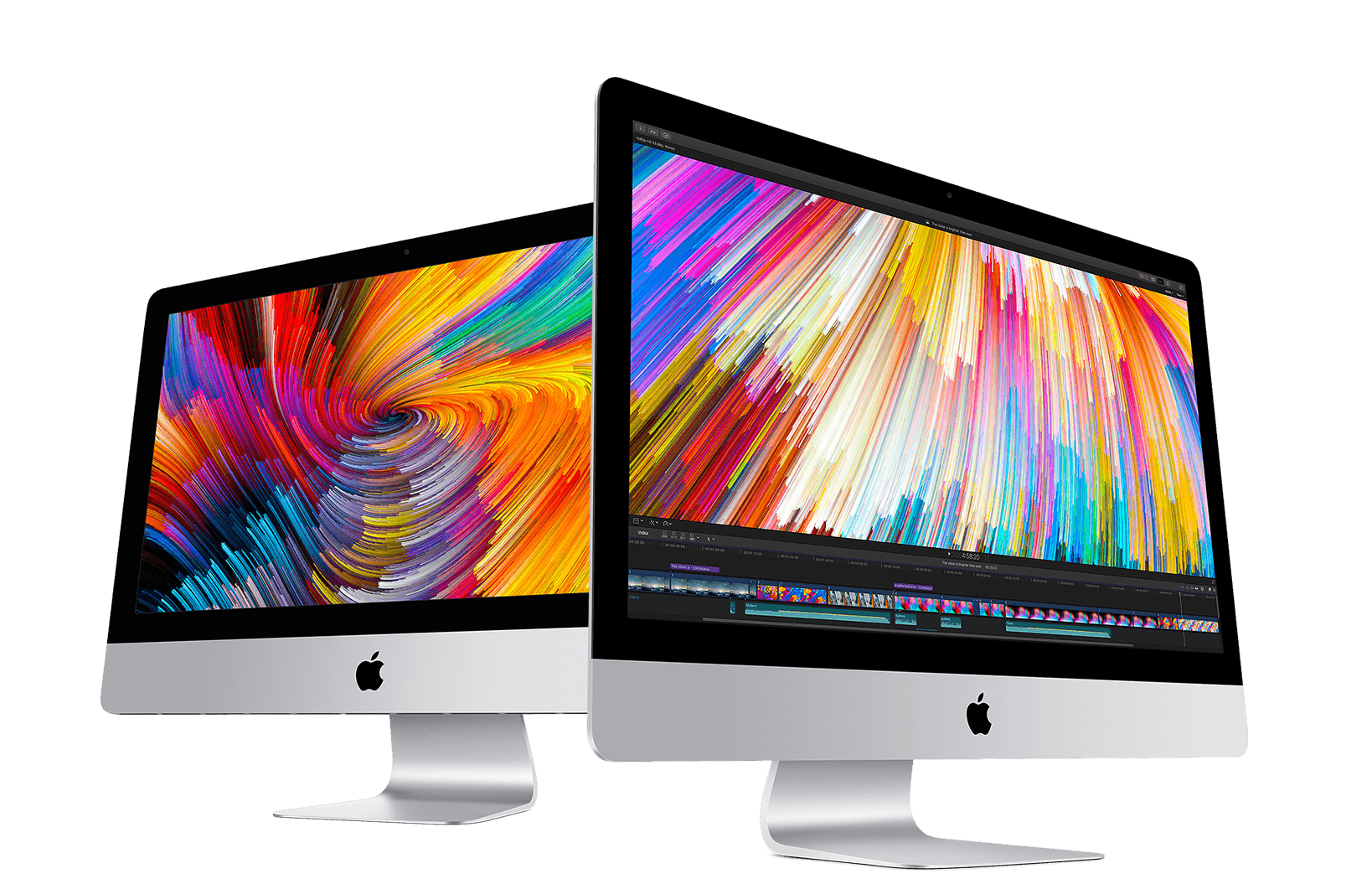Smart TV
When you flick this TV on, you’re greeted with one of many different smart TV homescreens. These can be customised to show different widgets, such as a channel explorer, or icons for the TV on-demand apps that you use most often. It’s a clever idea and gets rid of the clutter that other smart TV systems suffer from.
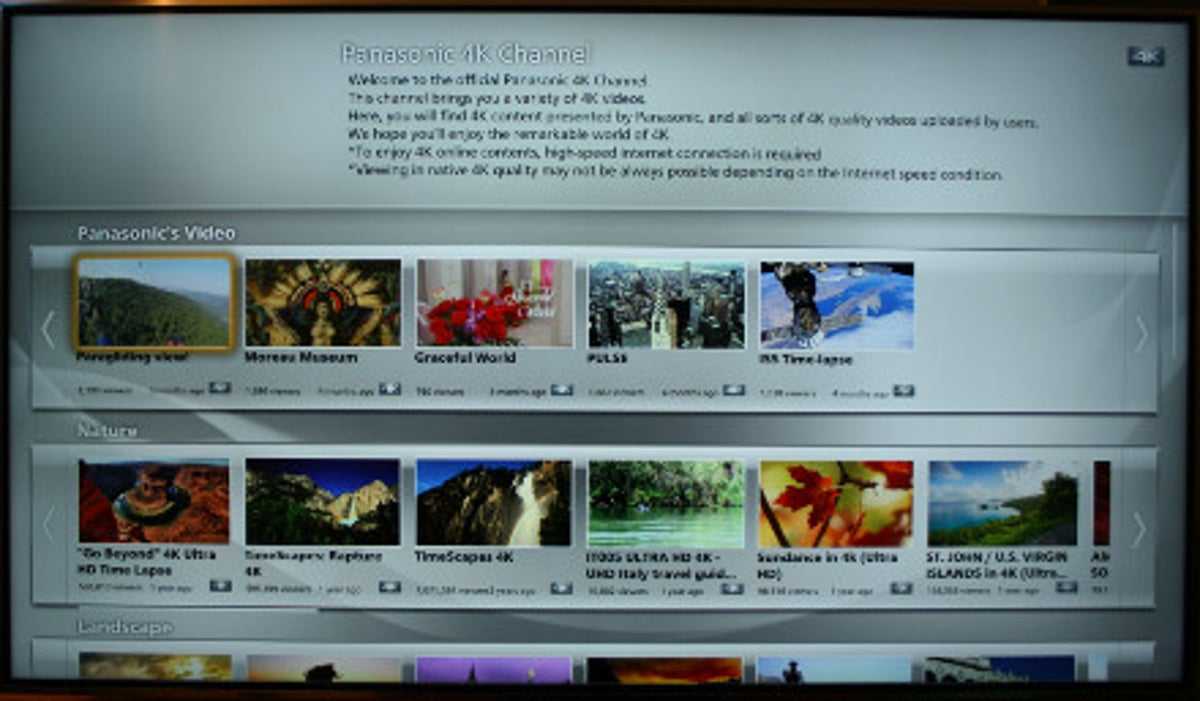
Panasonic’s smart TV systems could do with better support for more catch-up TV services.
The TX-L65WT600B doesn’t offer as many apps as Samsung’s smart TVs — it does include Netflix (HD only, not 4K) and BBC iPlayer, but lacks support for 4oD, Lovefilm and ITV Player.
The set has a 4K enabled Web browser onboard, and a media player that supports playback of 4K video files encoded using the H.264 compression scheme. There’s no HEVC decoder onboard though — unlike LG’s 65LA970W — so it can’t play files encoded using that format. This also means that you’re not going to see a 4K compatible Netflix app released for this TV when the service starts supporting 4K streams of shows such as House of Cards in February — a major downer as it’ll be one of the few sources of 4K video.
Panasonic has added its own 4K channel as an app, but the quality of the streams isn’t great as most of the footage suffers from MPEG blocking and looks worse than good quality 1080p video, even when streaming via a 60Mbps Virgin Media Internet connection.
Audio quality
Sony strapped almost comically huge speakers to the sides of its KD-65X9005 and LG added a slick, motorised, drop-down soundbar to its 65LA970W. It’s a shame then that Panasonic has stuck with pretty standard down firing stereo speakers on this model.
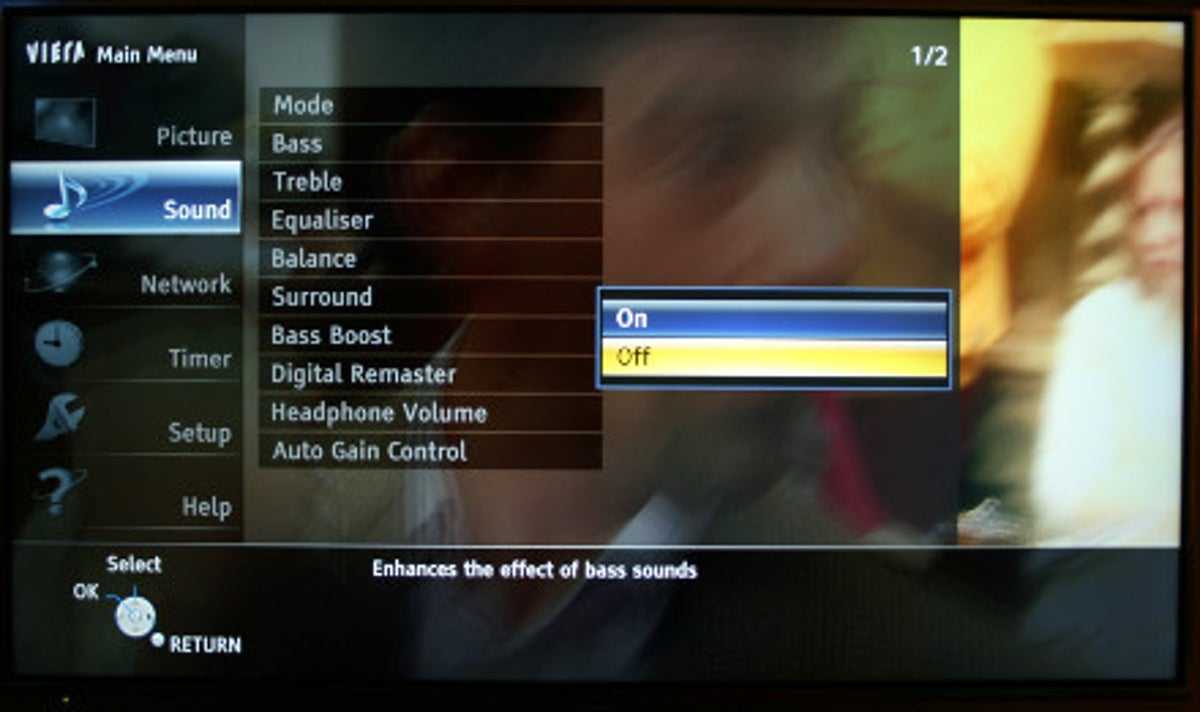
The Panasonic TX-L65WT600B is quite weak when it comes to sonics.
The results are distinctly average. The WT600 doesn’t sound bad, but it doesn’t sound good either. It lacks the full-bodied sonic prowess of Sony’s X9005 and doesn’t have the mid-range punch of LG’s model. Dialogue still sounds crisp and clean, but it’s crispy when dealing with high frequency sounds, and where you should hear bass rumbles you get flaccid, mid-range boominess instead. It’s not terrible by any means, but it falls short of the solid audio performance its two peers that I tested recently.
Performance
To evaluate the screen in full native 4K, I hooked up a media server brimming with UHD content acquired by Panasonic and Eurosport. What makes this particular 4K collection interesting is that it’s of a natively high frame rate. To play it out, I utilised the DisplayPort connection. While the WT600 may have been the first in line for an HDMI 2.0 input, it still has to wait until someone produces a source with a compatible output. That’s not an issue with DisplayPort, which can deliver 3,840 x 2,160-pixel content at 60Hz from a compatible PC graphics card.
The material, comprising show jumping and car racing, proves jaw-droppingly beautiful, both in terms of detail and smoothness. Travelogue footage, including a weather-beaten but richly detailed Rikers Island, as well as after-dark sequences of Las Vegas glittering with pinpoint lighting, off ers a level of screen realism that Full HD just doesn’t come close to. It’s like swapping out your double glazing for prescription glass. In truth I’m not entirely sold on the concept of HFR for all content.
While the silky detail suits sports, I find it less acceptable for movies, as it removes the artifice that’s become part of the lexicon of cinema and TV drama. It’ll be interesting to see what the 4K iteration of Blu-ray will off er in this regard. As an oversized Ultra HD gaming monitor, the panel is equally spectacular. Playing Project Cars at 60Hz via DisplayPort on a 65in screen is probably the nearest you’ll ever get to a full-on race simulator. An increasing number of graphics cards support 4K, including nVidia’s Quadro and GeForce series, as well as AMD’s Radeon HD 7000 and FirePro models. A growing selection of gaming titles should more than help pass the time until UHD video becomes more readily available.
In addition to native 4K, the set demonstrated its upscaling talents with Blu-ray and HD broadcasts, a database of 120,000 textures used to interpolate additional detail, demonstrated to great eff ect on the Total Recall mastered in 4K disc. The screen also has a direct 1080p mode, which applies simple linear pixel quadrupling. It’s debatable, though, if the latter is actually better than you’d get from a Panasonic ZT65 1080p plasma or Pioneer Kuro. Subjectively, I prefer the PDPs. Black levels also don’t quite match the reference depths of the brand’s plasmas – although they are pleasingly stable, and the colour punch of this LED-lit panel is excellent.
The TV is 3D enabled and employs active shutter technology. While there is crosstalk double imaging evident, the set does a decent enough job of keeping stereophonic images clean and bright. For non-critical viewing, it’s okay The TX-L65WT600 is the first 4K/ UHD screen to really give a taste of tomorrow’s viewing experience, and it’s an extraordinary piece of kit. Presumptuously futureproofed with both HDMI 2.0 and DisplayPort 1.2a, Panasonic has produced a genuinely forward thinking 4K TV. It also looks great in the living room and off ers a superior connected experience. Even the price tag seems astonishingly reasonable.
Pros
- Outstanding native 50/60Hz 4K image quality
- HDMI 2.0 compatible
- DisplayPort 1.2a compatible
- Excellent MyHome Screen interface
Performance
The company provided a media server with some 4K content at 60fps (frames per second), and we are thoroughly impressed by what we see.
Part of the footage is a classic American car driving through a desert setting. The depth, the attention to detail and the general clarity are all superb – motion is dealt with confidently and the lines of the car’s bodywork and interior are sharply drawn.
There’s a real sheen to the paintwork, with the sun reflecting off it vividly. And the sand of the surroundings almost reveals itself grain by grain.
Panasonic TX-L65WT600
This Panasonic WT600 is no slouch with non-4K content either. There are decent Freesat and Freeview HD tuners on board, with Freesat just inching ahead in quality.
The TV’s a strong performer and even standard-def channels upscaled to its massive 3840 x 2160-pixel resolution are watchable.
Of course the switch from standard Channel 4 to HD brings benefits in terms of clarity and depth, although some rivals have slightly more punch.
Panasonic TX-L65WT600: Features
As the premium screen in Panasonic’s panel posse, there’s nothing missing from the WT600’s feature slate. The brand’s My Home Screen Smart TV interface allows you to customise your app and streaming TV experience, and includes a native 4K resolution web browser, while the inclusion of multiple tuners also opens up novel viewing options, from MultiView windows to smartphone integration. However, its key provision is HDMI 2.0 compatibility and a 4K-capable DisplayPort input. The latter is particularly useful as it can be used right here, right now to play 4K games at 60 frames per second via a tricked-out PC and graphics card. So how has Panasonic effectively leap frogged the current HDMI 1.4K standard which tethers the other 4K set makers? Because it owns a semiconductor business able to manufacture HDMI 2.0 compatible silicon, that’s how.
Panasonic TX-L65WT600: Характеристики
Как премиальный экран в наборе панелей Panasonic, в наборе функций WT600 нет ничего лишнего. Фирменный интерфейс My Home Screen Smart TV позволяет настраивать приложение и возможности потокового телевидения и включает собственный веб-браузер с разрешением 4K, а включение нескольких тюнеров также открывает новые возможности просмотра, от окон MultiView до интеграции со смартфоном.
Однако его ключевым условием является совместимость с HDMI 2.0 и вход DisplayPort с поддержкой 4K. Последнее особенно полезно, поскольку его можно использовать прямо здесь и сейчас, чтобы играть в игры 4K со скоростью 60 кадров в секунду через навороченный ПК и видеокарту.
Так как же Panasonic удалось обойти нынешний стандарт HDMI 1.4K, который связывает других производителей телевизоров 4K? Потому что он владеет полупроводниковым бизнесом, способным производить кремний, совместимый с HDMI 2.0, вот как.
Performance
The company provided a media server with some 4K content at 60fps (frames per second), and we are thoroughly impressed by what we see.
Part of the footage is a classic American car driving through a desert setting. The depth, the attention to detail and the general clarity are all superb – motion is dealt with confidently and the lines of the car’s bodywork and interior are sharply drawn.
There’s a real sheen to the paintwork, with the sun reflecting off it vividly. And the sand of the surroundings almost reveals itself grain by grain.
Panasonic TX-L65WT600
This Panasonic WT600 is no slouch with non-4K content either. There are decent Freesat and Freeview HD tuners on board, with Freesat just inching ahead in quality.
The TV’s a strong performer and even standard-def channels upscaled to its massive 3840 x 2160-pixel resolution are watchable.
Of course the switch from standard Channel 4 to HD brings benefits in terms of clarity and depth, although some rivals have slightly more punch.
General picture quality
For general viewing the WT600B is a decent TV, but not as good as I’d expect for a set costing over three grand. Its colour performance is very good though — landscape scenery looks excellent and subtle hues and textures such as skin tones are rendered with grace.
Its upscaling engine also does a decent job of both scaling up 1080p video to fill 4K’s worth of pixels and tarting up all but the lowest bit rate channels on Freeview. On the whole though, standard definition content looks worse here than on a good 1080p screen, such as Panasonic’s own ST60 model, and HD sources don’t look any better on this display than they do on a native 1080p screen.
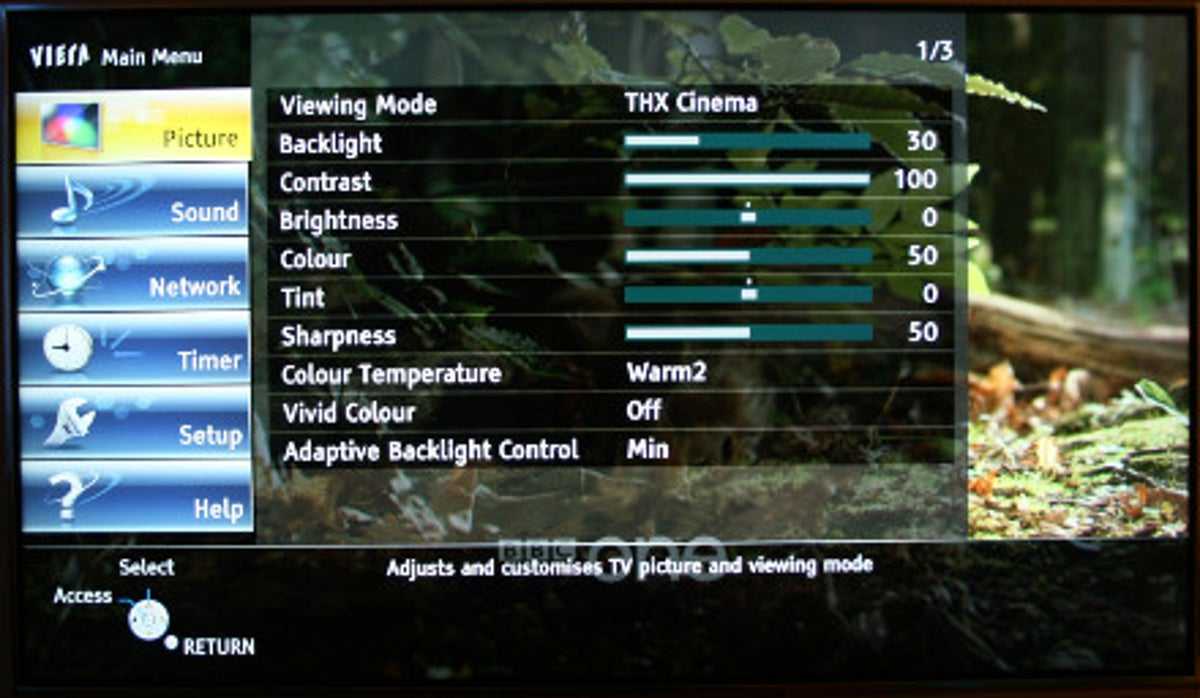
Upscaling performance is good, but black levels are a weak point.
The WT600 seemed slightly worse than Sony’s X9005 in terms of motion resolution, with more blurring on moving objects and sports footage. It’s biggest failing though is its black levels. As you’d expect, this is most noticeable under low light conditions.
The native black levels of the panel aren’t particularly good and a fair amount of cloudiness from the backlighting was visible in the four corners of the display. It has edge dimming, so it can reduce the intensity of the backlight, but Panasonic’s dimming system on this set is just nowhere near as effective as Sony’s dimming system on the X9005.
Design and connections
The WT600 follows the lead of Panasonic’s previous high-end sets, such as the WT60. It features a thin, metal stand holding the TV aloft to give it a floating-on-air look and an attractive narrow, chrome bezel. Given its 65-inch screen, the TV is huge, but the design looks lighter and more elegant than Sony’s slab like KD-65X9005, and even LG’s 65LA970W. Overall, it’s probably the best looking 4K TV around at the moment.
Panasonic supplies two remotes with the set. The standard zapper is almost identical to the one that ships with its other TVs, apart from the fact that it has a silver finish to match the TV’s styling. It’s a fine remote, as it has chunky, responsive buttons and a backlight that you can activate to make out the markings on individual buttons if you’re watching the TV with the lights dimmed.
The secondary remote is less successful. It’s essentially a touchpad remote, and although I liked the trigger-like OK button on the bottom, I found the remote just wasn’t as pleasant or as easy to use as Samsung’s similar touchpad remote or LG’s magic remote.

This model has both a DisplayPort socket and an HDMI 2.0 port.
Of course, one of the things that makes the TX-65WT600B more interesting than other 4K TVs currently on the market is that it can handle 4K video at 60 frames per second. There are two ways you can feed these sources into the telly. You can either use its sole 4K compatible HDMI port or alternatively use its DisplayPort — a video port more commonly found on computer monitors than on TVs.
Sadly the set’s other three HDMI ports don’t accept 4K signals at all — they only work with Full HD sources. Seeing as there’s pretty much nothing bar a laptop that you can currently use to feed 4K video into this kind of TV, that’s not much of an issue right now. But in the future, if you’ve got a 4K set-top box, 4K Blu-ray player and a 4K laptop, it’s going to make life awkward.
The other connections are the same you’d expect to find on any high-end TV. As this model has dual Freeview and Freesat tuners, there are two satellite dish inputs and a single RF input. You can also connect up component or Scart kit via short break-out cables and there are three USB ports. Hook up a hard drive to one of these and you can use the set as a full blown PVR thanks to the dual Freesat and Freeview HD tuners. There’s also Wi-Fi and an Ethernet socket onboard for the telly’s fancy smart TV features.
3D picture quality
Panasonic has opted to use active rather than passive 3D on this set, which isn’t a clever move in my opinion. One of the big benefits of both the Sony and LG 4K TVs that I looked at recently was that even though they used the passive 3D system, the 4K resolution of their panels meant that they were still able to deliver crisp 1080p video to each eye without the flicker and heavy glasses associated with active 3D systems.
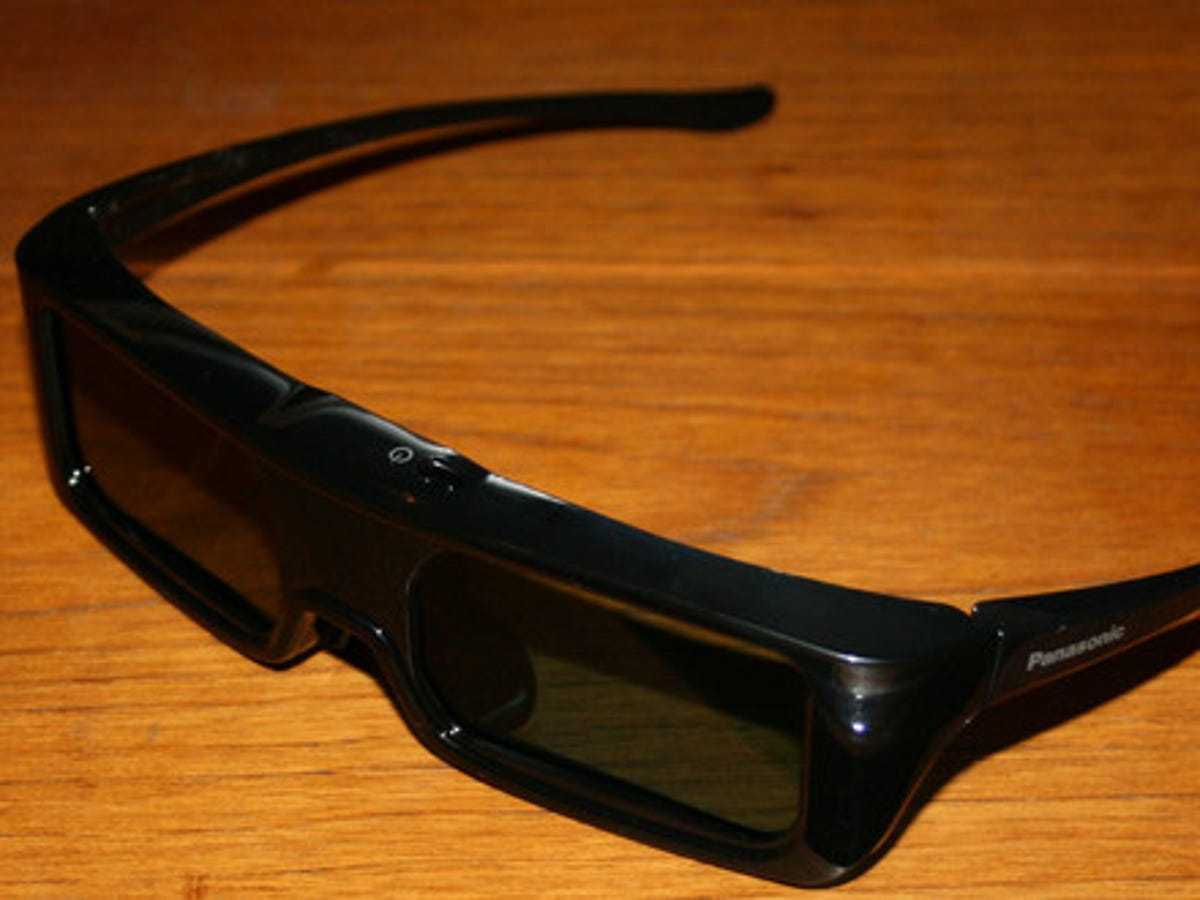
The set uses active 3D technology, when passive 3D would have been a better fit.
Panasonic includes two pairs of glasses with this TV, which is stingy given its extremely high price — Samsung includes four active specs with its current 4K model. The same downsides associated with active 1080p systems are also evident here. The active glasses do cause some flicker on ambient light in your room, and this combined with their extra weight make them less comfortable to wear for the duration of a movie.
This set also suffers from crosstalk. Watching Hugo I often spotted ghosting creeping in. It was especially noticeable in scenes where there were brighter objects in the foreground against a darker background, such as on the boy’s outstretched hand in the scene where he reaches for the wind-up mouse. The upshot is that this just doesn’t compare favourably to Sony’s and LG’s 4K sets.
TV guide
This model’s menu system looks almost the same as that used on Panasonic’s other TVs this year. It lacks some of the swish aesthetics of the menus found on LG and Samsung sets, but it’s speedy to use and more importantly gives you plenty of control over picture and audio settings. It’s easy to tweak the motion processing for example, and along with the standard brightness, contrast and colour controls, there’s also a full colour-management system.
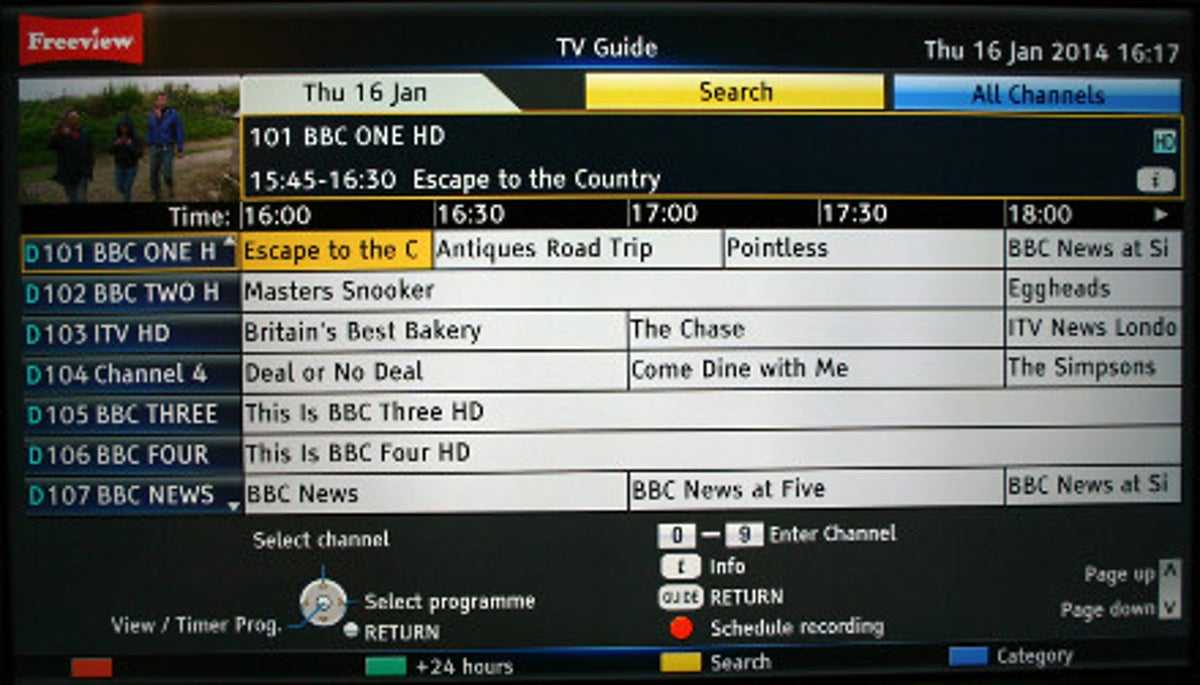
The programme guide has a video window, but the overall presentation is dull.
Panasonic has improved its EPG too. It’s added a video thumbnail window so you can keep an eye on the programme you were watching while you peruse the guide. The guide looks blocky and dated compared to Samsung’s version though, and it lacks Samsung’s Tivo-like recommendation engine.
Operation
There’s no major menu redesign to be found on the TXL65WT600, and that’s fine by us because Panasonic’s menus have been clear and legible for as long as we can remember, anyway. The text is rendered at native 4K resolution, and the icons have been redone to take advantage of the higher resolution, too.
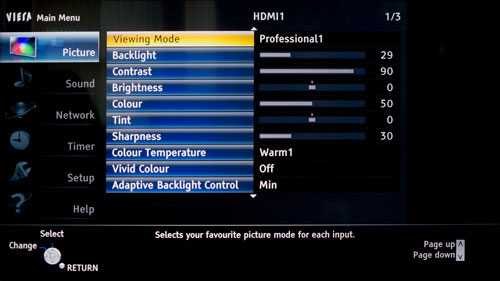 |
| menu |
All of the advanced picture controls we’d expect are in here, and on top of the basic adjustments (for Backlight level, Contrast, Brightness and so on), we have greyscale and gamma refinement menus (with 10-point precision), and a full three-axis colour management system for primary and secondary colours. (You’re having your £5,500 4K TV calibrated – right?)
We’re mainly used to these menus from Panasonic’s plasmas (RIP), but the TX-L65WT600B has some LCD-specific and 4K-specific adjustments included as well. The most obvious is , which adjusts the intensity of the LEDs according to the brightness level specified by the video signal itself. Even the best of these implementations will reveal some brightness shifting if the LEDs and the software controlling them can’t respond quickly enough to sudden changes in brightness, but overall we feel that these systems are worth it when they’re carefully implemented (as Panasonic’s is). Of course, in a perfect world we wouldn’t need them, but the design of LCD means light control is a good idea to avoid dark scenes appearing “lit up”, and until 4K OLED is affordable…
 |
| menu |
The submenu has access to the system (which bypasses options video purists don’t care about in order to avoid loss of colour resolution) and its counterpart, . We turned both on in order to keep the processing path as straightforward as possible.
There’s also the option to use a simpler 1080p->2160p (HD->UltraHD) upscaling mode, called which we’ll talk more about later.
Panasonic TX-L65WT600: Features
As the premium screen in Panasonic’s panel posse, there’s nothing missing from the WT600’s feature slate. The brand’s My Home Screen Smart TV interface allows you to customise your app and streaming TV experience, and includes a native 4K resolution web browser, while the inclusion of multiple tuners also opens up novel viewing options, from MultiView windows to smartphone integration. However, its key provision is HDMI 2.0 compatibility and a 4K-capable DisplayPort input. The latter is particularly useful as it can be used right here, right now to play 4K games at 60 frames per second via a tricked-out PC and graphics card. So how has Panasonic effectively leap frogged the current HDMI 1.4K standard which tethers the other 4K set makers? Because it owns a semiconductor business able to manufacture HDMI 2.0 compatible silicon, that’s how.
Audio quality
Sony strapped almost comically huge speakers to the sides of its KD-65X9005 and LG added a slick, motorised, drop-down soundbar to its 65LA970W. It’s a shame then that Panasonic has stuck with pretty standard down firing stereo speakers on this model.
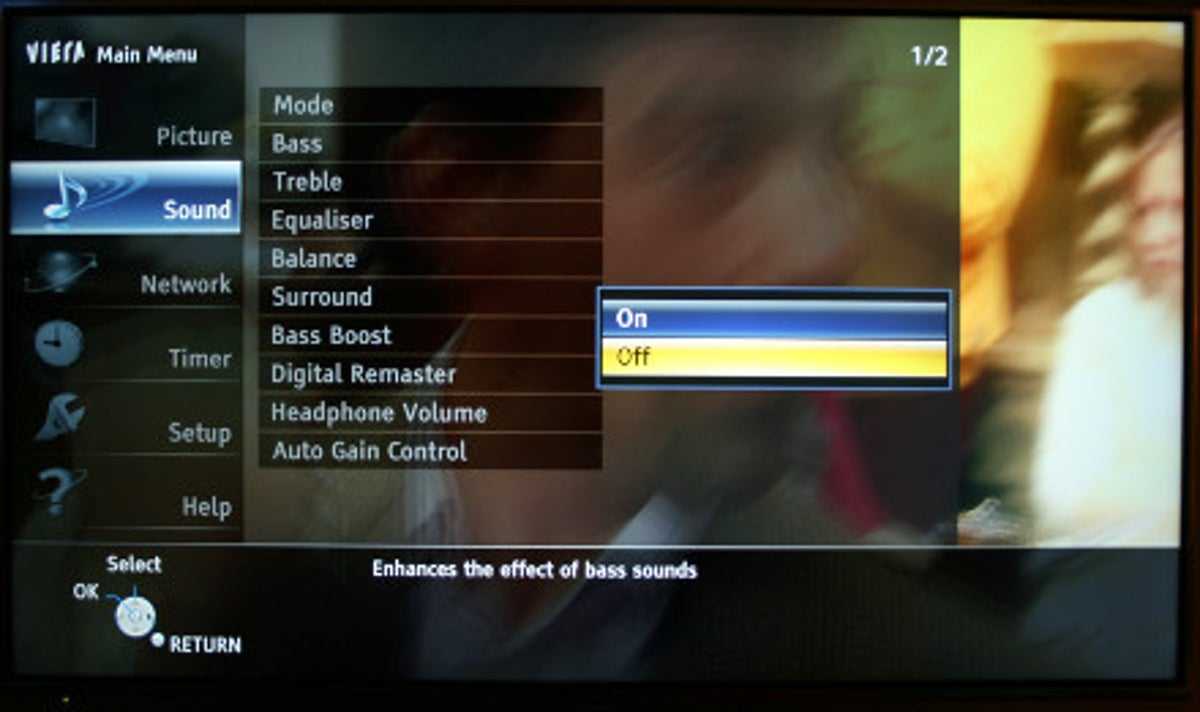
The Panasonic TX-L65WT600B is quite weak when it comes to sonics.
The results are distinctly average. The WT600 doesn’t sound bad, but it doesn’t sound good either. It lacks the full-bodied sonic prowess of Sony’s X9005 and doesn’t have the mid-range punch of LG’s model. Dialogue still sounds crisp and clean, but it’s crispy when dealing with high frequency sounds, and where you should hear bass rumbles you get flaccid, mid-range boominess instead. It’s not terrible by any means, but it falls short of the solid audio performance its two peers that I tested recently.
Panasonic TX-L65WT600: Set Up
Thanks to its comprehensive and straightforward onscreen installation instructions when you first turn it on, the L65WT600 is one of the easiest TVs around to set up. Establishing your own personalised content hub – something we strongly suggest you take the time to do – is also brilliantly straightforward.
Things are a bit more complicated when it comes to picture setup, though.
If you’re a fairly serious film fan, we guess you might want to use either the THX Bright Room or THX Cinema presets as your set up starting point. However – and this is a pretty big however – while these settings deliver very accurate colour settings, we personally didn’t find them the best option when watching upscaled HD or standard def footage. Probably because their default position is to turn off as much image processing as possible, when a touch of extra processing help can actually be useful given the huge challenges involved in converting HD and standard def sources to 4K.
With the upscaled HD viewing that will make up the vast majority of your viewing in the short term, we personally would recommend at the very least using the Resolution Remaster option on Auto, along with the Adaptive Contrast feature set to medium (for reasons we’ll get into in the Picture Quality section). Though you shouldn’t need the MPEG NR so long as your HD feed is of half-decent quality.
The THX presets are more effective for native 4K UHD content, though, where turning off most of the processing options – aside from the Adaptive Contrast one – is the cleanest option.
One last setting to mention when it comes to the L65WT600’s scaling of HD and standard definition is the set’s interesting Pixel By 4Pixels mode. The idea with this is that rather than using Panasonic’s powerful Hexa Processing engine to calculate the best appearance of the extra pixels required to turn HD and standard def into 4K UHD, it simply produces four copies of each pixel to deliver a 1080p-emulating image that contains no ‘invented’ picture information.
Catering for image purists in this way is a thoughtful touch, even if from our 4K-loving point of view the lure of a ‘proper’ 4K image is very strong, even when many of the pixels in the image are computer-generated.
Panasonic TX-L65WT600: Verdict
As near to future proof as we might dare hope, this impressive Ultra HD debutant offers a scintillating viewing experience.
If you’re running a high-end gaming PC, it should be viewed as an extravagant cinematic monitor upgrade. As a premium gogglebox it takes some beating too. If you want to watch the future of television today, the Panasonic TX-L65WT600 is the only way to do it.
However, with very little 4K content currently available, it’s hard to recommend spending over five grand on it and prices will inevitably come down when more content becomes available. If there was enough content available to watch on it, this would definitely be a five-star TV.Panasonic TX-L65WT600 release date: Out now Panasonic TX-L65WT600 price: £5,499
Smart TV
When you flick this TV on, you’re greeted with one of many different smart TV homescreens. These can be customised to show different widgets, such as a channel explorer, or icons for the TV on-demand apps that you use most often. It’s a clever idea and gets rid of the clutter that other smart TV systems suffer from.
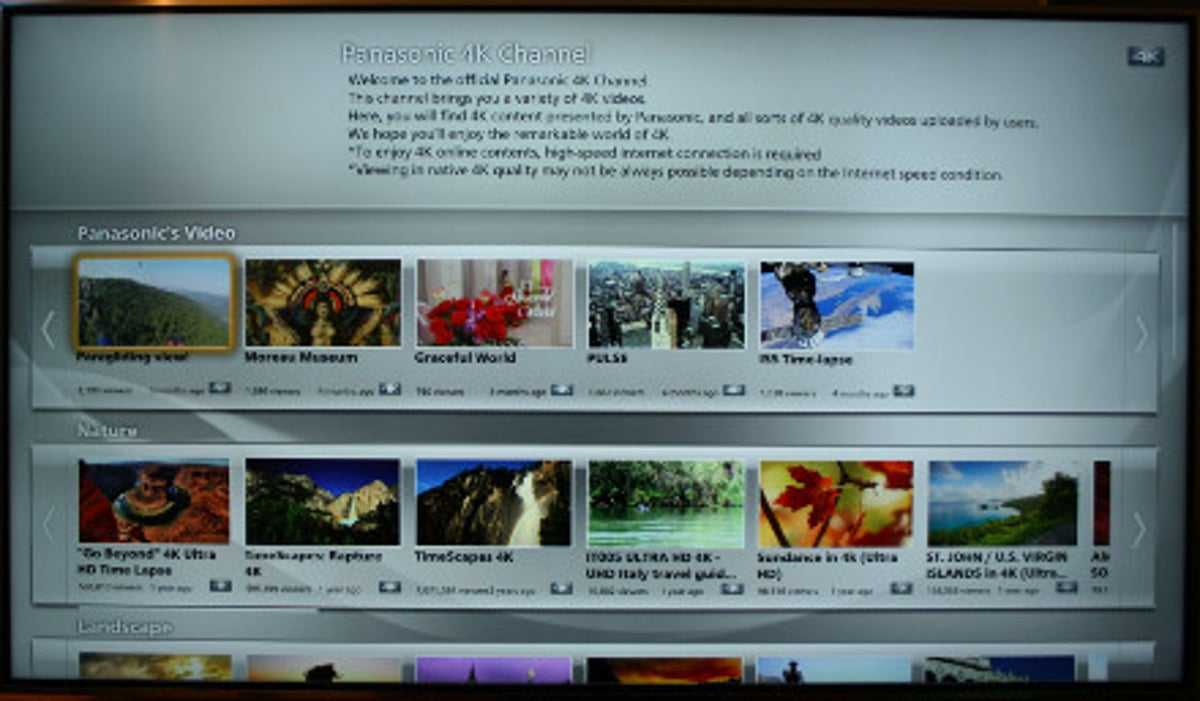
Panasonic’s smart TV systems could do with better support for more catch-up TV services.
The TX-L65WT600B doesn’t offer as many apps as Samsung’s smart TVs — it does include Netflix (HD only, not 4K) and BBC iPlayer, but lacks support for 4oD, Lovefilm and ITV Player.
The set has a 4K enabled Web browser onboard, and a media player that supports playback of 4K video files encoded using the H.264 compression scheme. There’s no HEVC decoder onboard though — unlike LG’s 65LA970W — so it can’t play files encoded using that format. This also means that you’re not going to see a 4K compatible Netflix app released for this TV when the service starts supporting 4K streams of shows such as House of Cards in February — a major downer as it’ll be one of the few sources of 4K video.
Panasonic has added its own 4K channel as an app, but the quality of the streams isn’t great as most of the footage suffers from MPEG blocking and looks worse than good quality 1080p video, even when streaming via a 60Mbps Virgin Media Internet connection.
Panasonic TX-L65WT600: Performance
We’ve waxed long and lyrical over the image quality available from first-generation 4K televisions. With 8m pixel density they offer photographic smoothness, even with upscaled Full HD content. But none deliver 4K resolution running at 60Hz. Hooked up to a PC media player this screen is capable of a kind of hyper reality. The picture demands you get closer, just to savour the fine delineation. Test footage of high frame rate 4K looks mind-bogglingly fabulous. As a preview of what to expect from those inevitable 4K TV services, it’s absolutely mouthwatering. Importantly the WT600 also looks terrific with upscaled Blu-ray and Full HD TV. There’s a wealth of calibration options for tweakers, but if you can’t be bothered to fiddle, the screen is THX 4K certified and offers well-considered THX Cinema and Bright Room presets. Audio performance is little more than functional though — disappointing for such a forward-thinking product.
Телевизоры с диагональю экрана 65 дюймов
Телевизор Sony Bravia KD-65X9005A – ещё один гость из нашего материала 2013 года. За прошедшее время аппарат скинул треть своей стоимости, отчего его достоинства стали ещё весомее (заметим, что в прошлом году за такую сумму Sony продавала похожий телеприёмник – но с разрешением Full HD).
Даже будучи выключенным, Sony Bravia KD-65X9005A привлекает к себе внимание – дизайнеры компании приложили немало фантазии и усилий, чтобы превратить фронтальную поверхность аппарата в произведение искусства. Результатом их труда стало инженерное решение сочетающее единую стеклянную поверхность и лунки динамиков. Последние также запаяны в стекло – что стало возможно благодаря использованию ферромагнитной жидкости вместо демпфера колебаний диффузора
Последние также запаяны в стекло – что стало возможно благодаря использованию ферромагнитной жидкости вместо демпфера колебаний диффузора.
Из перечня передовых технологий, включённых в функции телевизора, можно упомянуть поддержку портами HDMI спецификаций версии 2.0 (это произошло благодаря новой прошивке) и поддержку пультом дистанционного управления синхронизации с различными мобильными устройствами по каналу NFC.
Sony Bravia KD-65X9005A
Качество изображения, интерполяции Full HD в Ultra HD, стереоизображения и звука у Sony Bravia KD-65X9005A до сих пор остаётся если не передовым, то крайне достойным. Даже лучшие современные модели 2014 года выпуска не могут соревноваться с этим телевизором. Особенно если речь идёт о совокупности параметров, их общем балансе и соотношении со стоимостью аппарата.
Новый для рынка телевизор Panasonic Viera TX-L(R)65WT600 действительно заслуживает внимания, оказанного ему нашими экспертами. Аппарат впервые был продемонстрирован во второй половине 2013 года на выставке IFA 2013 и позиционировался там как современное и универсальное решение для дома.
К технологическим достоинствам Panasonic Viera TX-L(R)65WT600 в первую очередь можно отнести экран на матрице IPS, настройке цветопередачи которой на заводах Panasonic уделяют особое внимание. Такая тщательность отмечена сертификатом ISF (Imaging Science Foundation), что говорит о многом. Для придания телевизору универсальности конструкция Panasonic Viera TX-L(R)65WT600 включает в себя большое количество портов и дополнительных компонентов
Так порты HDMI изначально поддерживают стандарт версии 2.0. В пару к HDMI в телевизоре имеется порт DisplayPort версии 1.2а для беспроблемного подключения к Panasonic Viera TX-L(R)65WT600 компьютеров
Для придания телевизору универсальности конструкция Panasonic Viera TX-L(R)65WT600 включает в себя большое количество портов и дополнительных компонентов. Так порты HDMI изначально поддерживают стандарт версии 2.0. В пару к HDMI в телевизоре имеется порт DisplayPort версии 1.2а для беспроблемного подключения к Panasonic Viera TX-L(R)65WT600 компьютеров.
Panasonic Viera TX-L(R)65WT600
Функции SmartTV, традиционно включающие в себя наличие клиента службы видеочата Skype у Panasonic Viera TX-L(R)65WT600, имеют особую поддержку в виде встроенной Web-камеры. Наконец, широкие возможности проигрывания медиафайлов предполагают подключение носителей не только к портам USB, но и установку флэш-карт во встроенный слот SD.
Наконец, нельзя не заметить, что в Panasonic Viera TX-L(R)65WT600 установлено два цифровых тюнера, позволяющих распараллелить процессы просмотра и записи эфира, а также отвечающих за полноценную реализацию режима «картинка-в-картинке». Стоит сказать, что ещё год назад установка двух тюнеров считалась практически нормой на рынке телевизоров Ultra HD. Однако сегодня подобные модели уже приходится искать целенаправленно.
| Sony Bravia KD-65X9005A | Panasonic Viera TX-L(R)65WT600 | |
| Экран | 65’’ UltraHD 800 Гц | IPS 65’’ UltraHD 2000 Гц |
| 3D |
Поляризационная технология, конвертация из 2D |
Затворная технология, конвертация из 2D |
| Особенности |
Звук 8 динамиков, динамик АС с ферромагнитной жидкостью на стекле |
Web-камера, слот SD, 2 тюнера, голосовое управление |
| Коммуникация |
4xHDMI 2.0, 3xUSB, AV, 2xАудио, компонентный, SCART, RGB, MHL, Ethernet Wi-Fi 802.11n, Miracast, NFC |
4xHDMI 2.0, 3xUSB, AV, компонентный, SCART, RGB, Ethernet, Bluetooth, Wi-Fi 802.11n, DisplayPort |
| Звук | 4 канала: 2×20+2×12,5 Вт | 3 канала: 2×4+1х10 Вт |
| Цена | i 200 тыс. | i 220 тыс. |
Design and connections
The WT600 follows the lead of Panasonic’s previous high-end sets, such as the WT60. It features a thin, metal stand holding the TV aloft to give it a floating-on-air look and an attractive narrow, chrome bezel. Given its 65-inch screen, the TV is huge, but the design looks lighter and more elegant than Sony’s slab like KD-65X9005, and even LG’s 65LA970W. Overall, it’s probably the best looking 4K TV around at the moment.
Panasonic supplies two remotes with the set. The standard zapper is almost identical to the one that ships with its other TVs, apart from the fact that it has a silver finish to match the TV’s styling. It’s a fine remote, as it has chunky, responsive buttons and a backlight that you can activate to make out the markings on individual buttons if you’re watching the TV with the lights dimmed.
The secondary remote is less successful. It’s essentially a touchpad remote, and although I liked the trigger-like OK button on the bottom, I found the remote just wasn’t as pleasant or as easy to use as Samsung’s similar touchpad remote or LG’s magic remote.
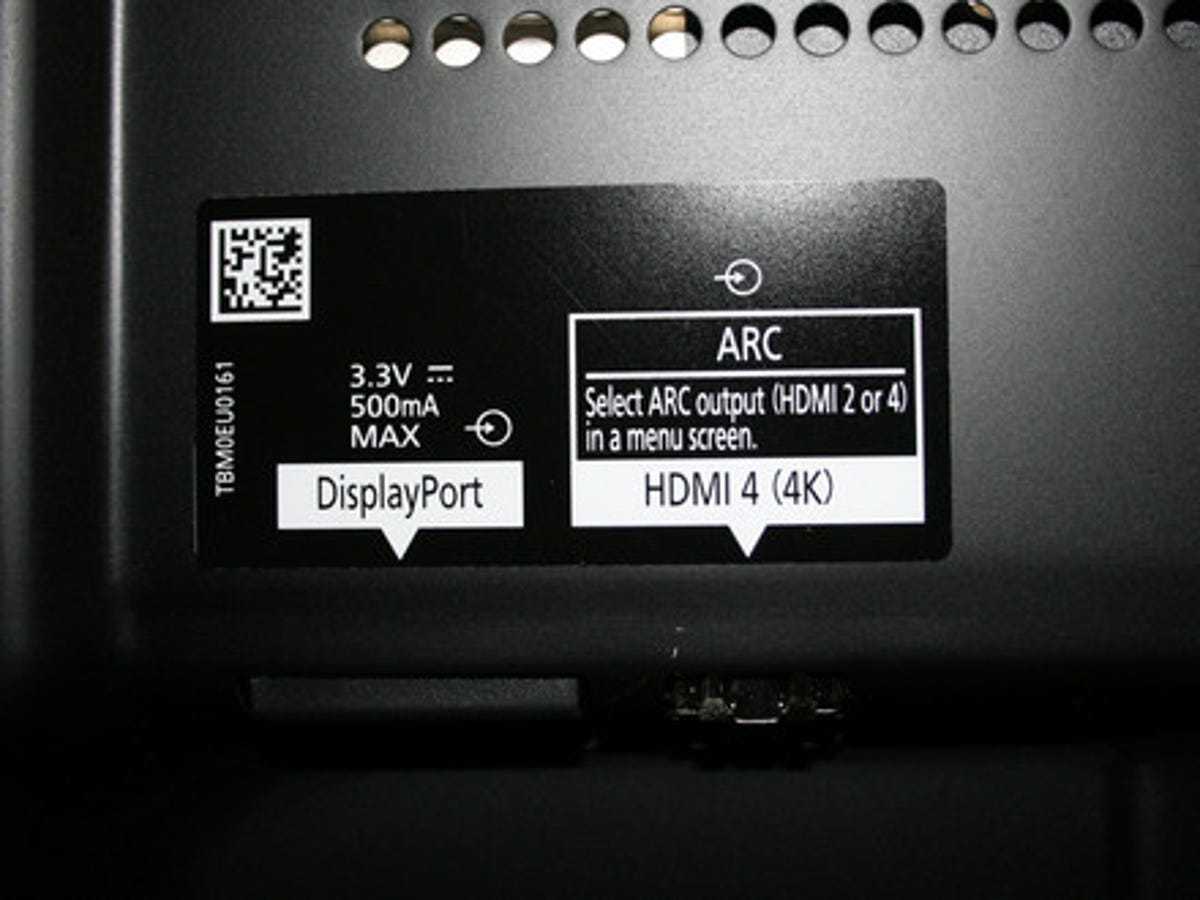
This model has both a DisplayPort socket and an HDMI 2.0 port.
Of course, one of the things that makes the TX-65WT600B more interesting than other 4K TVs currently on the market is that it can handle 4K video at 60 frames per second. There are two ways you can feed these sources into the telly. You can either use its sole 4K compatible HDMI port or alternatively use its DisplayPort — a video port more commonly found on computer monitors than on TVs.
Sadly the set’s other three HDMI ports don’t accept 4K signals at all — they only work with Full HD sources. Seeing as there’s pretty much nothing bar a laptop that you can currently use to feed 4K video into this kind of TV, that’s not much of an issue right now. But in the future, if you’ve got a 4K set-top box, 4K Blu-ray player and a 4K laptop, it’s going to make life awkward.
The other connections are the same you’d expect to find on any high-end TV. As this model has dual Freeview and Freesat tuners, there are two satellite dish inputs and a single RF input. You can also connect up component or Scart kit via short break-out cables and there are three USB ports. Hook up a hard drive to one of these and you can use the set as a full blown PVR thanks to the dual Freesat and Freeview HD tuners. There’s also Wi-Fi and an Ethernet socket onboard for the telly’s fancy smart TV features.
4K picture quality
Unfortunately there isn’t much 4K content available to watch on a screen like this. Netflix is about to start streaming shows in 4K in February, but this TV won’t support them due to a lack of HEVC decoding. Panasonic did supply some test footage on a USB key to view on the TV and we were also able to use some other 4K footage we’ve gathered in MKV and MP4 formats.
As with other 4K screens we’ve seen, when you’re up-close the footage looks incredible. The pixels are so tightly packed together that the detail on offer really does look amazing.
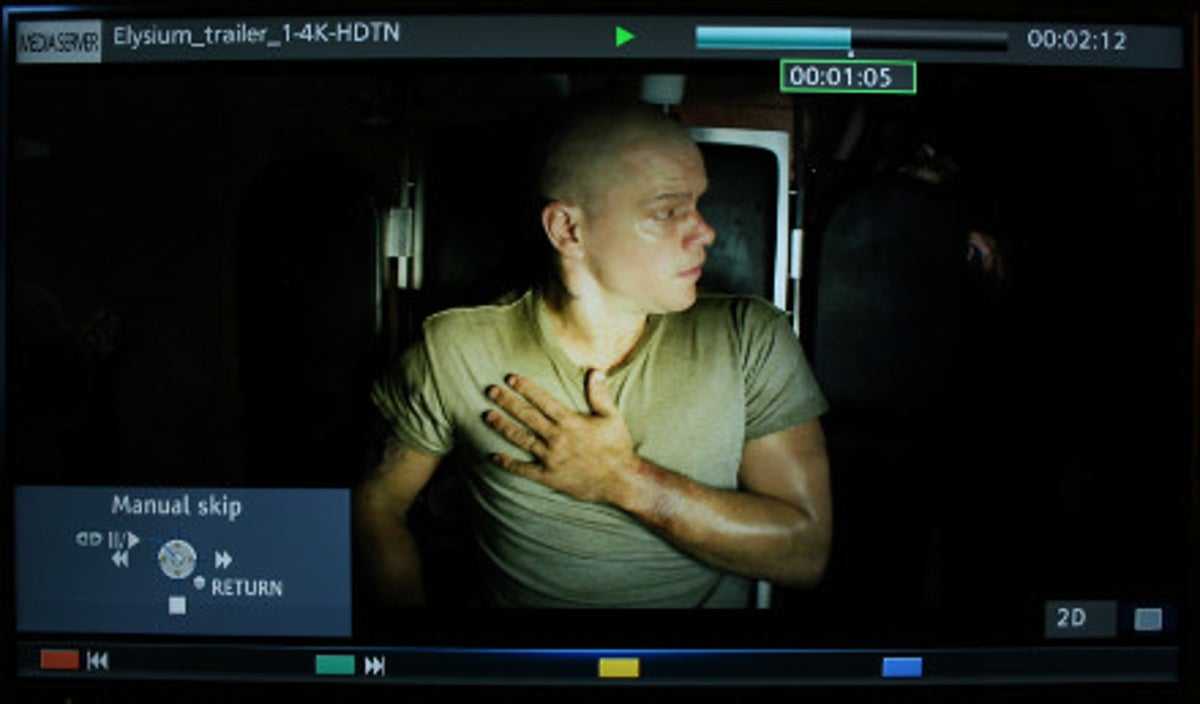
Up-close, 4K footage looks amazingly detailed.
As you step back from the TV though, the difference between 4K and 1080p is less noticeable. At around 4ft you can still resolve the extra detail, but move back to a more comfortable and normal viewing distance and it’s much harder to tell.
At around 8ft I found it pretty difficult to see much difference at all between 1080p and 4K video. Sharp text on movie trailers stands out, but in standard video sequences at that kind of viewing distance it’s not hugely apparent.
